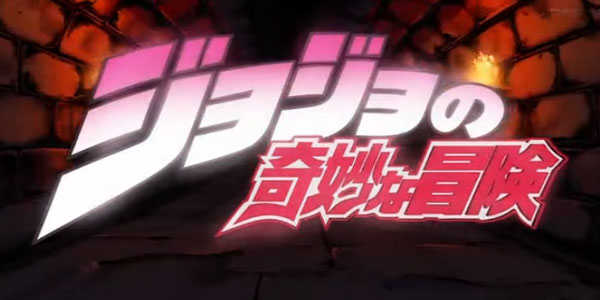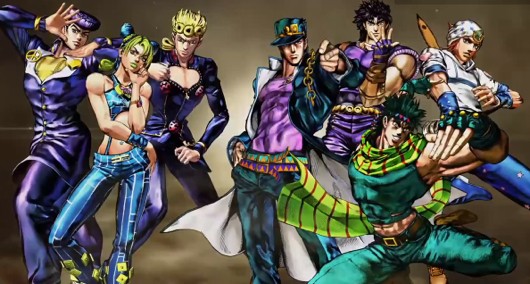Last updated on September 15, 2013
JoJo’s Bizarre Adventure – I suppose I could tell you simply to read the title of the show, and let that be that. Still, I do WRITE, so maybe I should WRITE about this.
JoJo’s Bizarre Adventure came into being the year I was born, 1987; since then, the manga by Hirohiko Araki exploded in popularity within its native country (Japan, duh), becoming a major influence on shoujun (serialized) manga throughout the country. Remember that Dragon Ball, Akira Toriyama’s crazy kung-fu story, only hit around 1985, and you can see that both of them changed the cultural landscape. JoJo’s manga sold over seventy million copies in Japan alone, so clearly there’s something to it.
Now, you might wonder: why did we never see JoJo in America, at least in any significant leap for manga and anime in North America? For one, America’s not too much into foreign exports; on another level, children in this country aren’t exposed to quite so much “violence” in their media. Even our comic books restricted this until recently, while JoJo makes little apology for its brutal, and disturbing, content. Furthermore, while Dragon Ball remains palatable to our American sensibilities (hey, it’s a martial arts thing with aliens and fireballs), JoJo takes various portions of world history and usurps our common tropes without any care for sensitivity outside of Japan. Series 2 of JoJo, Battle Tendency, uses the Nazis as a source of humor AND as good guys; if that doesn’t offend someone, I don’t know what will.
Even now, though, JoJo’s relatively obscure in the States. If it isn’t for the aformentioned reasons, it could be because Araki uses copyrighted names all over the place, especially that of Western rock musicians and band names (R.E.O. Speedwagon, for example, or even DIO, RIP). Araki, apparently, does not wish to change his work due to copyright laws (except for the one with the mosque…). In fact, JoJo yanks influence from every conceivable source, from popular psychology to philosophy to martial arts flicks, horror, comedy, Indiana Jones-style serials, and supernatural elements. It’s a genreless mix, a melting pot of stuff seemingly thrown in at random, yet Araki turns the tale into something truly special.
My first encounter came from the CPS3 arcade game JoJo’s Bizarre Adventure; I picked up a copy at GameStop by chance for the Dreamcast (as usual for the system, it’s an arcade perfect port) for ten dollars. The game, luckily, had a story mode which revealed the ongoing motivations of the characters, and I was immediately intrigued. What are “Stands”? What about Ripple? Why the heck am I in Egypt, and is that guy a vampire? Man, it’s confusing but fun. Also, cowboys, why cowboys? Honestly, I found my fun and let the game collect dust. The recent release of JoJo’s Bizarre Adventure: All-Star Battle reinvigorated my interest, and so I am talking about it now.
So what’s is it about, exactly? Well, from the name, we know of JoJo, which comes from the name Jonathan Joestar, a wealthy nobleman. His family ends up in a crash when he’s a young boy, killing his mother but leaving the other two alive. At the same time, Dario Brando attempts to steal the elder Joestar’s wedding ring, but in his weakened state Joestar believes that Mr. Brando is actually helping him; thus do the two families central to JoJo’s conflict first meet.
While Jonathan Joestar lives a happy existence and learns of compassion and faith in humanity, Dario Brando’s son Dio learns of the exact opposite. He learns of alcoholism, of hate, and of despair, the worst parts of the human experience. When Dario Brando finally dies (under mysterious circumstances…), the Joestar family seeks to repay the misguided debt by adopting Dio into their family. Unfortunately, Dio’s a scoundrel who wishes to prove his superiority to everyone else, even to JoJo.
This quest to “beat’ JoJo at everything turns into a mad quest for power, and Dio stumbles upon an ancient mask (located in Joestar’s briefcase during the crash). Unsurprisingly for a Japanese manga/anime, Dio uses the mask to grant himself great power and turns into a vampire. So yes, a competition between noble sons (one adopted) turns into a horror/vampire tale. Dio kills JoJo’s father to do this, and JoJo vows to eliminate what Dio became and the evil things he does. The two families, bound by fate, continues to fight throughout the decades, starting in the late 1800s and eventually coming to the modern day. Their descendants continues the blood feud (to say why, of course, spoils the story)
If this sounds like the most absurd premise to a story, the word “Bizarre” never so accurately described the frequent genres switches and the story whiplash. From one moment you might see a ritual sacrifice in grisly detail; in another, a fascinating card game, and in yet another some humor at JoJo’s expense. It’s truly weird, but that gives it a lot of character. Seeing what happens to the various people in the Joestar family lines and how they get out of absurd situations is part of the fun, and it’s almost hilarious how crazy it gets.
Even so, there’s a human element at its core, and common themes of friendship and shared humanity work throughout. Motivations might seem random at first, but each character displays some philosophical outlook on how the world should proceed, whether ruled by one superior or left to its own devices. As well, the fact that NO CHARACTER IS SAFE (the capital letters emphasize this fact) means that the twists and turns shock and amaze. The historical element here allows Araki to turn a rollicking adventure into a sudden tearjerker. What I told you merely sets the story into play, but the individual events can shock even the most stalwart of fans. Be forewarned for emotional climaxes (and maybe crying…not that I would ever admit that…)
As far as media goes, the manga continues (only the third series found an official release in North America), but the new anime series allows you to get into the fray without needing to read reams of material. The DVD release exclusive to Japan, interestingly, contains English subtitles. Less savory means also exist if you don’t feel like spending a hundred dollars for two episodes. Perhaps the game might also pique your interest? Whatever the case, JoJo gives us a uniquely Japanese story that, frankly, couldn’t exist anywhere else.
Would I recommend it? 100% yes! If you want to understand Japanese culture of the last thirty years (storytelling, imagery, and otherwise), you owe it to yourself to have even a vague familiarity with JoJo. Also, everyone in the show looks FABULOUS:


